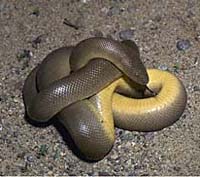| Charina | |
|---|---|
 | |
| Rubber boa, C. bottae | |
| Scientific classification | |
| Kingdom: | Animalia |
| Phylum: | Chordata |
| Class: | Reptilia |
| Order: | Squamata |
| Suborder: | Serpentes |
| Family: | Boidae |
| Subfamily: | Erycinae |
| Genus: | Charina Gray, 1849 |
| Synonyms [1] | |
Charina is a genus of nonvenomous boas, commonly known as rubber boas, found in North America. Two species are currently recognized. [2]
